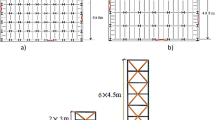Abstract
This study focuses on the optimal cost design of reinforced concrete retaining walls (RCRWs) depending on the flower pollination algorithm (FPA) under seismic loading. The objective function used to minimize the total cost is formed considering the costs of construction materials under the constraints implemented by Turkish Building Earthquake Code-2018 (TBEC-2018). Parametrical analyses have been performed to acquire the optimum design, and diversification of the cases has been formed with the use of different combinations of material costs and soil properties. Four different combinations that were formed as the couples of both concrete and steel costs have been used considering the adopted maximum and minimum costs of the materials throughout the world. Besides, the soil properties have been identified considering the limitations of common soil specifications explained in the well-known literature. In this context, subject to TBEC-2018, three different soil classes have been used, and hence the effect of the differentiation of the peak ground acceleration values has been investigated. As a result, optimum design charts for RCRWs in terms of the base width and wall height have been acquired considering the variants of the analysis.












Similar content being viewed by others
References
AASHTO (American Association of State Highway and Transportation Officials) (2002) Standard specifications for highway bridges, American Association of State Highway and Transportation Officials, USA
ACI (American Concrete Institute) (2005) Building code requirements for structural concrete. ACI 318–05. USA
Ahmadi-Nedushan B Varaee H (2009) Optimal design of reinforced concrete retaining walls using a swarm intelligence technique. The first international conference on soft computing technology In: Topping BHV, Tsompanakis Y (eds) Civil, structural and environmental engineering. Civil-Comp Press, Stirlingshire
Alghaffar MAA, Dymiotis-Wellington C (2005) Reliability analysis of retaining walls designed to British and European standards. Structure and Infrastructure Engineering Maintenance, Management, Life-Cycle Design and Performance 1(4):271–284. https://doi.org/10.1080/15732470500030455
Al-Shukur AK, Al-Rammahi AMM (2017) Optimum Design of Semi-Gravity Retaining Wall Subjected to Static and Seismic Loads. Int J Civ Eng Technol (IJCIET) 8(1):873–881
Aydogdu I (2017) Cost optimization of reinforced concrete cantilever retaining walls under seismic loading using a biogeography-based optimization algorithm with Levy flights. Eng Optim 49(3):381–400. https://doi.org/10.1080/0305215X.2016.1191837
Bekdas G, Akbay Arama Z, Kayabekir AE, Geem ZW (2020) Optimal design of cantilever soldier pile retaining walls embedded in frictional soils with harmony search algorithm. Appl Sci 10(9):3332:1–17
BS (British Standard) (1997) 8110–1:1997 Structural use of concrete-Part 1: Code of practice for design and construction, Committee of British Standard, BS-8110–1
CEN (Europen Committee for Standardization) (1997) Geotechnical design-Part 1: General rules, Europen Committee for Standardization, Eurocode 7. CEN, Brussells
CEN (Europen Committee for Standardization) (1998) Design of structures for earthquake resistance-Part 1:General rules, seismic actions and rules for bildings, Europen Committee for Standardization, Eurocode 8. CEN, Brussells
Chen H, Asteris PG, Armaghani DJ, Gordan B, Pham BT (2019) Assessing Dynamic Conditions of the Retaining Wall: Developing Two Hybrid Intelligent Models. Appl Sci 9:1042–1055. https://doi.org/10.3390/app9061042
Das BM (2010) Principles of Foundation Engineering. Cengage Learning, Stamford
Gandomi AH, Kashani AR, Roke DA, Mousavi MH (2017a) Optimization of retaining wall design using evolutionary algorithms. Struct Multidisc Optim 55:809–825
Gandomi AH, Zeighami KAR, F, (2017b) Retaining wall optimization using interior search algorithm with different bound constraint handling. Int J Numer Anal Meth Geomech 41:1304–1331
Ghaleini EN, Koopialipoor M, Momenzadeh M, Sarafraz ME, Mohamad ET, Gordan B (2019) A combination of artificial bee colony and neural network for approximating the safety factor of retaining walls. Engineering with Computers 35:647–658
Gokkus Yildirim MS, Yilmazoglu A (2018) Prediction of Concrete and Steel Materials Contained by Cantilever Retaining Wall by Modeling the Artificial Neural Networks. J Soft Comput Civ Eng 2–4:47–61
Goldberg DE (1989) Genetic algorithms in search, Optimization and machine learning. Addison-Wesley, Boston MA
Gordan B, Koopialipoor M, Clementking A, Tootoonchi H, Mohamad ET (2018) Estimating and optimizing safety factors of retaining wall through neural network and bee colony techniques. Eng. Comput 1-10. https://doi.org/10.1007/s00366-018-0642-2
Kennedy J, Eberhart RC (1995) Particle swarm optimization. In: Proc., IEEE International Conference on Neural Networks No. IV. Perth, pp 1942–1948
Konstandakopoulou F, Tsimirika M, Pnevmatikos N, Hatzigeorgiou GD (2020) Optimization of Reinforced Concrete RetainingWalls Designed According to European Provisions. Infrastructures 5:46–61. https://doi.org/10.3390/infrastructures5060046
Kumar VN, Suribabu CR (2017) Optimal Design of Cantilever Retaining Wall Using Differential Evolution Algorithm. Int J Optim Civil Eng 7(3):433–449
Liu L, Zhang M, Peng N, Chen J (2013) The Additional Parameters Identification in Cantilever Retaining Wall System Based on Finite Element Optimization. EJGE 18:4281–4291
Mergos PE, Mantoglou F (2019) Optimum design of reinforced concrete retaining wall with the flower pollination algorithm. Structural and Multidisciplinary Optimization 1–11. https://doi.org/10.1007/s00158-019-02380-x.
Mills-Curran WC, Schmit LA (1985) Structural Optimization with Dynamic Behavior Constraints. In Proc., 24th Structures, Structural Dynamics and Materials Conference, Lake Tahoe, pp 132–138
Mohammad FA, Ahmed HG (2018) Optimum Design of Reinforced Concrete Cantilever Retaining Walls according Eurocode 2 (EC2). Athens J Technol Eng 5(3):277–296
Rahbari P, Ravichandran N, Juang H (2017) Robust Geotechnical Design of a Retaining Wall Subjected to Earthquake Loads. Geotechnical Frontiers 2017:149–158
Ravichandran N, Wang L, Rahbari P, Juang CH (2020) Robust design optimization of retaining wall backfilled with shredded tire in the face of earthquake hazards. Bull Eng Geol Env 80:1351–1363. https://doi.org/10.1007/s10064-020-02038-9
Saribas A, Erbatur F (1996) Optimization and sensitivity of retaining structures. J Geotech Eng 122(8):649–656
Simpson B (1992) Retaining Structures: displacement and design. Geotechnique 42(4):541–576
TBEC-2018 (2018) Turkish Building Earthquake Code, Ankara, Turkey
TDTH. 2018 (2018) Türkiye Deprem Tehlike Haritaları İnteraktif Web Uygulaması. https://tdth.afad.gov.tr/TDTH/main.xhtml. Accessed 5 Jan, 2021
TS 7994 (1990) Soil Retaining Structures: Classification, Properties and Projecting Principles, Ankara, Turkey
TS-500 (2000) Requirements for Design and Construction of Reinforced Concrete Structures, Ankara, Turkey
Xu C, Gordan B, Koopialipoor M, Armaghani DJ, Tahir MM, Zhang X (2019) Improving Performance of Retaining Walls Under Dynamic Conditions Developing an Optimized ANN Based on Ant Colony Optimization Technique. IEEE Access 7:94692–94700. https://doi.org/10.1109/ACCESS.2019.2927632
Yang XS (2012) Flower pollination algorithm for global optimization, In Proc., International Conference on Unconven-tional Computation and Natural Computation 2012, Lecture Notes in Computer Science, Mathematics, Physics 7445:240–249
Author information
Authors and Affiliations
Corresponding author
Ethics declarations
Conflict of interest
On behalf of all authors, the corresponding author states that there is no conflict of interest.
Additional information
Responsible Editor: Zeynal Abiddin Erguler
Rights and permissions
About this article
Cite this article
Akbay Arama, Z., Dalyan, İ., Bekdaş, G. et al. Comparative analysis of factors influencing the optimal seismic design of retaining walls. Arab J Geosci 15, 547 (2022). https://doi.org/10.1007/s12517-022-09826-5
Received:
Accepted:
Published:
DOI: https://doi.org/10.1007/s12517-022-09826-5




